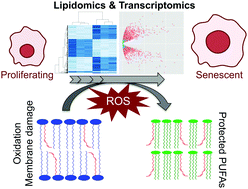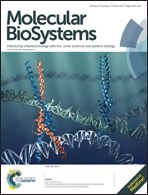Regulation of lipids is central to replicative senescence†
Abstract
Cellular replicative senescence, a state of permanent cell-cycle arrest, has been linked to organismal aging, tissue repair and tumorigenesis. In this study, we comparatively investigated the global lipid profiles and mRNA content of proliferating and senescent-state BJ fibroblasts. We found that both expression levels of lipid-regulating genes and the abundance of specific lipid families, are actively regulated. We further found that 19 specific polyunsaturated triacylglycerol species constituted the most prominent changes in lipid composition during replicative senescence. Based on the transcriptome analysis, we propose that the activation of CD36-mediated fatty acid uptake and diversion to glycerolipid biosynthesis could be responsible for the accumulation of triacylglycerols during replicative senescence. This, in turn, could be a cellular mechanism to prevent lipotoxicity under increased oxidative stress conditions observed in this process. Our results indicate that regulation of specific lipid species has a central role during replicative senescence.



 Please wait while we load your content...
Please wait while we load your content...